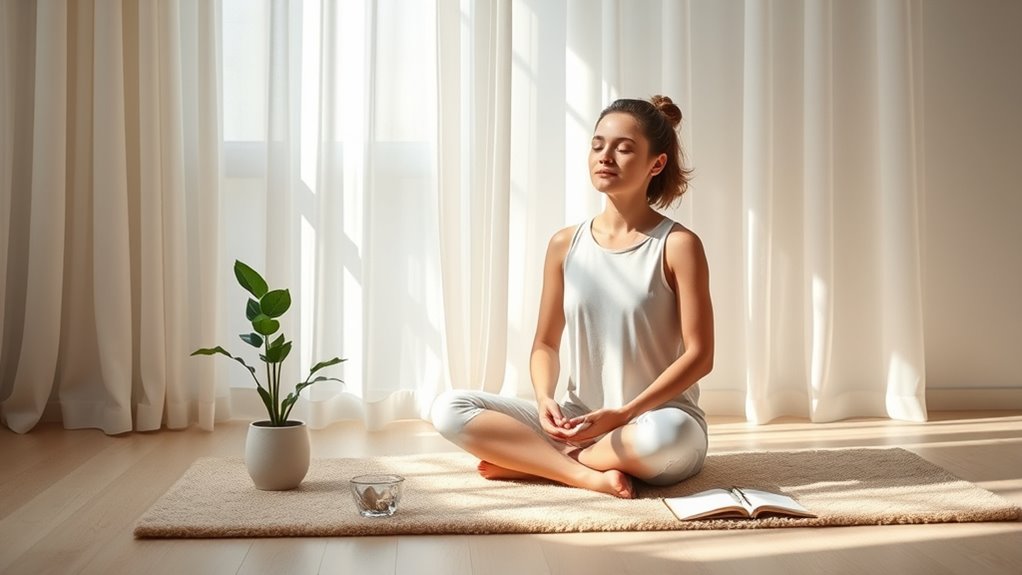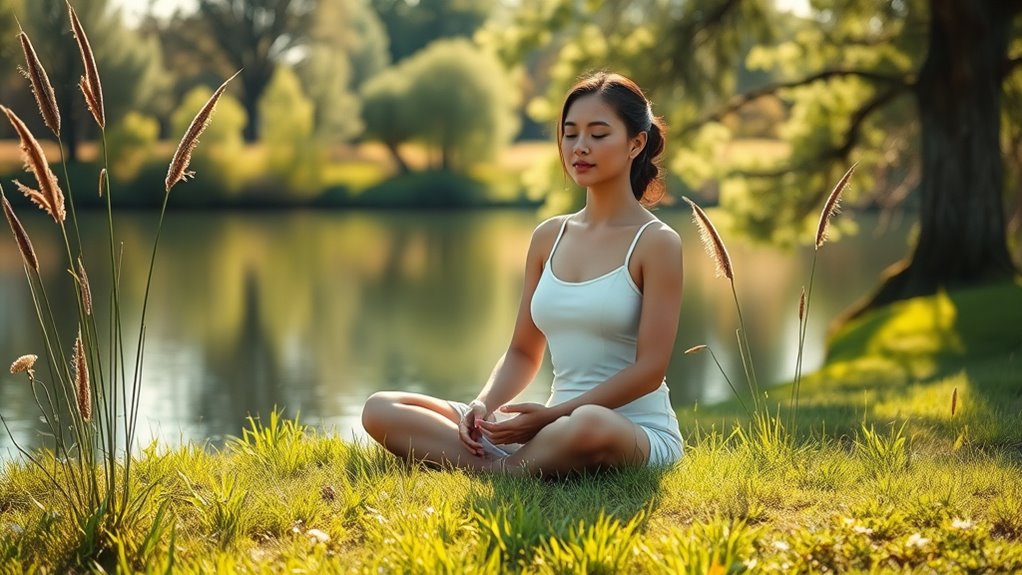Mindfulness is about intentionally paying attention to the present moment—your thoughts, feelings, sensations, and surroundings—without judgment. It’s not about emptying your mind, achieving perfect calm, or forcing your thoughts to stop. Instead, you observe what’s happening without trying to change it, fostering clarity and resilience. This practical practice can be integrated into daily routines. Keep exploring to discover more ways to deepen your understanding and experience of mindfulness.
Key Takeaways
- Mindfulness involves paying attention to the present moment without judgment or striving for a perfect mental state.
- It is not about emptying the mind or achieving complete relaxation, but about awareness and acceptance.
- Mindfulness includes observing thoughts and feelings without getting caught up in them.
- It can be practiced through simple techniques like focused breathing, body scans, or mindful walking.
- Consistent, short practice sessions integrated into daily routines are more effective than sporadic, lengthy ones.

Have you ever wondered how to find calm amid life’s chaos? If so, you’re not alone. Many people seek ways to manage stress and cultivate a sense of peace. One effective approach is mindfulness, a practice rooted in paying attention to the present moment without judgment. But to truly understand mindfulness, it helps to explore what it is—and what it isn’t. At its core, mindfulness isn’t about emptying your mind or achieving a perfect state of relaxation. Instead, it’s about intentionally bringing your awareness to what’s happening right now, whether that’s your breath, sensations in your body, or your surroundings. This awareness can be cultivated through various meditation techniques designed to foster calm and clarity. When you practice these techniques regularly, you often notice a significant reduction in stress levels, aiding in stress reduction and emotional resilience. Meditation techniques like focused breathing, body scans, or mindful walking are simple yet powerful tools for grounding yourself in the present. They serve as a means to disconnect from worries about the future or regrets about the past, helping you respond more thoughtfully to everyday challenges. It’s important to remember, though, that mindfulness isn’t about achieving a perfect state or forcing your mind to be still. Instead, it’s about observing your thoughts and feelings without getting caught up in them. This non-judgmental stance can be transformative, allowing you to recognize patterns of stress or distraction and gently return your focus to the present. Many people think mindfulness is some kind of spiritual practice, but it’s really accessible and practical for everyone. You can incorporate mindfulness into your daily routine, whether you’re eating, walking, or simply taking a few deep breaths. The key is consistency—short, frequent practice sessions tend to be more effective than sporadic, lengthy ones. Additionally, understanding industry trends and staying informed about new techniques can help deepen your practice and maintain motivation. By engaging in meditation techniques tailored to your needs, you’ll gradually develop a more balanced outlook and a greater capacity to handle life’s inevitable ups and downs. Remember, mindfulness isn’t a quick fix or a one-size-fits-all solution; it’s a skill that deepens over time, offering ongoing benefits for your mental and emotional health. Ultimately, it’s about cultivating a gentle awareness that allows you to navigate life’s chaos with more patience, clarity, and compassion, bringing a sense of calm that can truly transform your daily experience.
Frequently Asked Questions
Can Mindfulness Help With Severe Mental Health Conditions?
Mindfulness effectiveness varies for severe mental health conditions, but many find it a helpful supplement to treatment. It can help you manage symptoms like anxiety, depression, or stress by increasing awareness and reducing reactivity. However, mindfulness alone isn’t a cure; it should complement professional mental health treatment. You might experience improvements in emotional regulation and resilience, but always consult with a mental health provider to develop a thorough approach tailored to your needs.
Is Mindfulness Suitable for Children and Adolescents?
If you introduce mindfulness with child-friendly practices, it’s highly suitable for children and adolescents. For example, imagine a teenager using simple breathing exercises to manage anxiety during exams. Engaging adolescents with tailored activities helps them stay involved and benefit from mindfulness techniques. You can adapt practices to age, making it easier for young minds to develop emotional regulation and focus, fostering resilience and well-being in a supportive, age-appropriate way.
How Long Does It Take to See Benefits From Mindfulness Practice?
You can start noticing benefits from mindfulness practice within just a few weeks. The mindfulness duration needed varies, but many people see improvements in stress, focus, or mood after about 8 weeks of regular practice. Consistency is key; the more you practice, the quicker you’ll experience the benefits timeline. Keep at it, and you’ll likely see positive changes in your mental well-being sooner than you expect.
Are There Any Risks or Side Effects of Practicing Mindfulness?
Practicing mindfulness generally has minimal risks, but you should be aware of some mindfulness misconceptions. For example, it might bring up difficult emotions or memories, which can feel overwhelming if you’re unprepared. Potential drawbacks include feeling more anxious or disconnected if you force yourself into practice without proper guidance. To avoid these, start slowly, and consider working with a trained instructor, especially if you have a history of mental health issues.
What’s the Difference Between Mindfulness and Meditation?
Mindfulness is like shining a spotlight on your present moment, while awareness is the broad field it illuminates. Meditation techniques focus on cultivating either mindfulness or awareness, often through exercises like breathing or body scans. The main difference is that mindfulness is a skill you develop, actively observing your thoughts and feelings, whereas meditation techniques are tools to help you deepen that practice. Both work together to enhance your mental clarity and calm.
Conclusion
Now that you understand mindfulness, think of it as a gentle lighthouse guiding you through life’s stormy seas. It’s not about escaping chaos, but learning to navigate your thoughts and feelings with calm and clarity. As you practice, you’ll find yourself steering through daily moments with a steady hand and open heart. Remember, mindfulness isn’t a destination but a journey—so keep your lighthouse shining bright, illuminating your path to peace amidst the waves.










